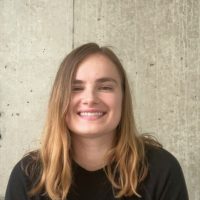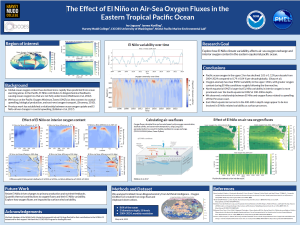
Ivy Jaguzny
Harvey Mudd College
Research Mentor: Jannes Koelling
Project: The effect of El Niño on ocean biogeochemistry and air-sea fluxes of oxygen
I’m Ivy Jaguzny, I study Chemistry at Harvey Mudd College, and I worked with Jannes Koelling at UW CICOES and NOAA Pacific Marine Environmental Laboratory. This summer, I explored how El Niño affects air-sea oxygen fluxes in the eastern tropical Pacific.
Ocean oxygen sustains many marine ecosystems and is declining over time; more rapidly than predicted from ocean warming alone. In the Pacific Ocean, El Niño contributes to biogeochemical feedbacks causing ocean oxygen loss that are not fully understood. The El Niño cycle, a mode of climate variability every 2-7 years, causes large-scale physical, chemical, and biological changes to the Pacific, including changes in temperature, precipitation, wind conditions, ocean currents, and biological production. In the eastern tropical Pacific, El Niño changes the strength of coastal upwelling of oxygen-poor, nutrient-rich water from the deep ocean to the surface off the coast of South America. During periods of greater upwelling, we observe a net uptake of oxygen from the atmosphere into the ocean in this region.
The eastern tropical Pacific is also the location of the largest Oxygen Minimum Zone (OMZ) in the world. Stronger coastal upwelling leads to increased phytoplankton growth at the surface, which dies, sinks, and is consumed by bacteria deeper in the water column. This process, and the relative stratification of the eastern equatorial Pacific maintains large ocean regions below 200m depth with very little dissolved oxygen. As OMZs intensify and expand, so does the potential for anoxic or hypoxic ocean chemistry and the release of greenhouse gasses.
To investigate changes in ocean oxygen on an El Niño timescale, I analyzed GOBAI-O2, a gridded data product from global ocean observations resolved over two decades and 2,000 m depth. Using this data product, I calculated air-sea oxygen fluxes from surface oxygen concentration, surface wind velocity, absolute salinity, and conservative temperature. I compared ocean oxygen content and oxygen air-sea fluxes during El Niño and La Niña conditions.
I recommend this opportunity to students considering graduate school in ocean or atmospheric science as a way to expand their general knowledge in their field of choice and gain experience with the research process. Through this experience, I learned how to build context in a field, manage my time, narrow my focus, struggle through coding problems, ask for help, receive feedback, ponder what the results mean, and communicate the big picture to multiple audiences. I gained confidence using Python to analyze and visualize large datasets. Also, I learned about the computational tools used by NOAA, like machine learning, as a chemist.
I met ocean and climate scientists at every stage of their careers; grad students, postdocs, and full research scientists at NOAA and the UW School of Oceanography who showed me what it’s like to work in their field. So many scientific disciplines in one place opened my eyes to the full variety of approaches needed to study the climate. Thank you to my mentor Jannes and to everyone who took the time to guide me this summer!
Project Introduction
Research Poster

